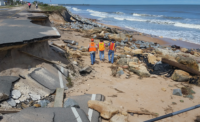I-95's southbound lanes re-opened on Oct. 12, and the northbound lanes opened the following day, eliminating a 168-mile detour. Meanwhile, SCDOT has deployed nearly 2,100 engineers from across its organization to conduct damage assessments on state-maintained roads in 23 counties. The inspections will help the agency to prioritize repair, recovery and replacement work.
SCDOT also made extensive use of social media to keep residents advised of road and bridge closures and share updates on the progress of repairs. One Facebook post highlighted agency employees teaming with Limehouse & Sons, Ladson, S.C., on a crane pick to reset a 115,000-lb approach slab on state Highway 41 in Berkeley County.
"We are also going a little above and beyond by helping counties and municipalities assess damage on non-state- maintained roads," Poore adds. "The actual construction and repair work will take months and months."
Leslie Hope, director of Carolinas Associated General Contractors' South Carolina divisions, says SCDOT could begin issuing contracts by the week of Oct. 19 "to start getting more into recovery mode." Hope adds that she knows of no contractors in the state that were severely affected by the floods. She says SCDOT already has been in contact with some of them, "lining them up and hoping to use their services going forward."
Financial help in restoring South Carolina's roads and bridges is already on the way in the form of an initial $5 million in emergency aid from the U.S. Dept. of Transportation. In a statement, DOT Secretary Anthony Foxx called the funding "only a down payment on our commitment to ensuring all highways and bridges are repaired in the state." Foxx also said more funding would be available after estimates of repair costs are calculated.
The Federal Emergency Management Agency (FEMA) likewise will require damage assessments before it can begin the process of aiding South Carolina's state and local governments under its public assistance grant program. A FEMA spokesperson says the agency has called on its private-sector technical-assistance contractors to provide general civil engineering guidance on roads and bridges and wastewater treatment plants.
FEMA had approximately $5.2 billion in its Disaster Relief Fund as of Sept. 30, according to an agency report, and will likely need a congressional appropriation to fund fully all response and recovery needs. While it may be weeks before the full cost of rebuilding South Carolina's infrastructure comes into focus, questions are being raised about whether a larger, ongoing investment in public works might have at least mitigated some of the flood damage.
Gov. Nikki Haley (R) repeatedly told reporters in her daily briefings that an analysis of what was and wasn't spent on infrastructure should be done after the flood danger has passed. The governor added that South Carolina was "fortunate" that only a handful of its approximately 2,400 state-regulated dams had failed due to the flooding. The state spent $260,000 on dam safety in 2014, the fourth-lowest amount in the nation, according to the Association of State Dam Safety Officials.
"We have been working with our state Legislature for years and asking them for years to supply [the] DOT with additional funds to help maintain our roads," says AGC's Hope. Although SCDOT's annual budget request earlier this year totaled $1.4 billion, South Carolina's General Assembly failed to enact any measure that would channel more money to roads, including raising a state gas tax that has remained 16¢ per gallon since 1987.
However, state lawmakers are discussing convening a special session of the General Assembly to discuss proposals such as a bond issue dedicated to road repairs.







Post a comment to this article
Report Abusive Comment